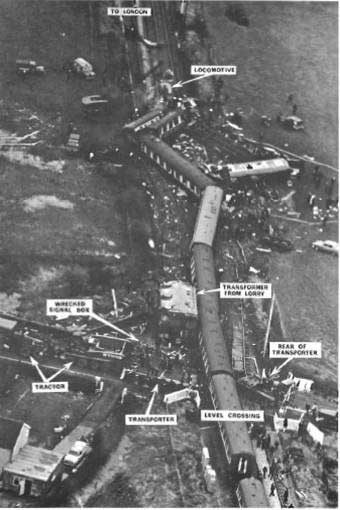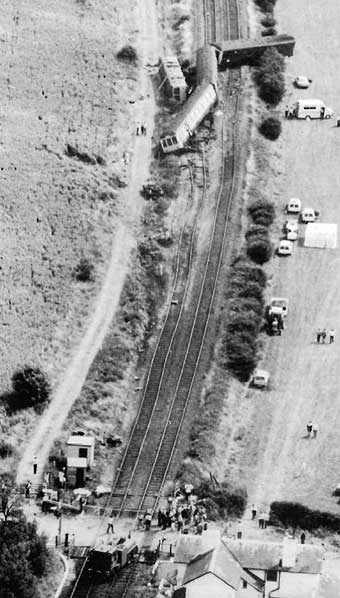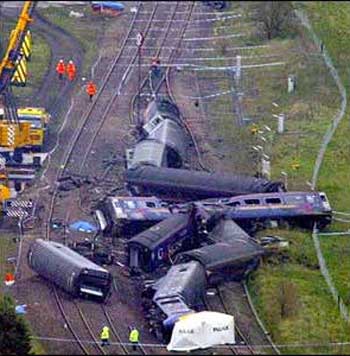haddonstuff - where underachievement is a badge of honour |
||||||
| Home | BigList | About | Contact | Pugh | Pugh | McGrew |
Level
Crossings |
Stuff
stuffed in this section Level crossing types - industry definitions Major incidents - key UK level crossing incidents Click on the stuff subject and watch it appear below as if by magic |
Major UK level crossing incidents HIXON 1968 Background A low loader, escorted by the police, was transporting a 120 ton transformer from Stafford to the English Electric site at Hixon, Staffordshire. Towards the end of its journey, the convoy had to cross the Automatic Half Barrier crossing (AHB) at Hixon. The incident The low loader moved at two miles an hour over the crossing to avoid grounding.. As it was doing so, the barrier warning and closure sequence was triggered by an oncoming train. Less than thirty seconds later, a Manchester-London express collided with the low loader and subsequently derailed. Eleven people were killed. Consequences A number of the recommendations made in the inquiry report were acted upon; explicit signage instructing drivers of slow vehicles to stop and call signalman; AHBs only used at two-line crossings, amber warning lights added to sequence, extended yellow-box road markings, 'special orders' for the movement of large, slow vehicles to incorporate directions to call signalman at crossings. Some recommendations were not acted upon at the time and are still a matter of research and revision (increased penalties for drivers who 'zigzag' around AHB barriers, installing strips to seperate carriageways on the approach to a crossing, revision of the Highway Code section on crossings).
LOCKINGTON 1986 Background A number of crossings on the two-track Bridlington - Hull line were converted from Manully Controlled Gates to Automatic Open Crossing (Remotely Monitored). This included the crossing at Lockington. The line was under threat of closure and the crossing conversion resulted in significant cost savings. The incident A 4-car Diesel Multiple Unit travelling from Bridlington to Hull stuck a van that had been driven onto the crossing. The lead unit derailed, ran down an embankment and jack-knifed. The second unit was forced over the opposite track. The two other cars derailed but stayed upright. Eight passengers in the train and a passenger in the van died. Fifty-nine people, including the train and van drivers, were taken to hospital. Consequences The AOCR had already been criticised as unreliable, of lights staying on red leading to locals ignoring the warnings and crossing anyway. The Stott inquiry launched after Lockington recommended the removal of AOCRs. Some were converted to Automatic Half Barrier - including Lockington. Others remained as Automatic Open Crossings but monitored by the train crew (AOC Locally Monitored). These use a white signal (the Driver's White Light) to show the train driver that the crossing system is functioning correctly. The train driver must ensure that the white light is lit on approaching the crossing. If the crossing systems fail, the crossing is left open to road users and the Driver's White Light is extinguished, warning the train driver that the crossing has failed. The driver can then call halt the train before the crossing.
UFTON NERVET Background Ufton Nervet Automatic Half Barrier(AHB) crossing is situated between Westbury and Reading on the main line between London and Plymouth. The incident A London-Plymouth High Speed Train (HST) struck a stationary car on the crossing. The lead car partially derailed and the train continued until meeting a set of facing points which resulted in catastrophic derailment. FIve passengers, the train driver and the car driver were killed. Seventy one passengers were treated at hospital. Consequences The formal inquiry made a wide range of recommendations. including consideration of a team dedicated to implementing Network Rail's policy of closing crossings where practicable. Also included was a call for research in a number of areas, including; detection of obstruction at AHBs, HST front end deflectors, seat belts for passengers, coach window design and specification.
|
Hixon 1968
Lockington 1986
Ufton Nervet 2004
|
||
Copyright © haddonsnet 2005 |
|||


